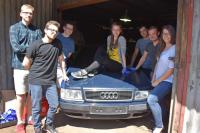Driving on the Edge – Meet Hybryda Science Club’s ProjectD
Drifting began at illegal races on Japan’s mountain tracks. Today, it is officially a sport with an increasingly large number of passionate fans. Students from the Warsaw University of Technology also want to fulfil their dream of participating in a drift championship. Will they make it?
Their 'Berry' stands in a sheet-metal garage, at the back of the WUT’s Faculty of Vehicles and Working Machines. It’s the nickname of the Audi (named so because of its colour) used by the students from Hybryda Science Club, Section ProjectD.
In June 2016, Adrian Połaniecki and Joanna Piwek, students of mechatronics at the Faculty of VaWM, decided to establish a science club, with the aim of building a drift car, and later participating in the Open Drift championship. They joined forces with Hybryda Science Club and created a new section there – ProjectD. 12 people are a part of this team, including 3 girls.
Their Own Four Wheels
Then, they began searching for the car that could form the base for preparations for the drift championships. After several months of searching for sponsors, Adrian Połaniecki decided to buy the car with his own money. Thus, the Club became the owner of a 1994 Audi 80 B4 Quattro.
Despite its age, the vehicle was in a very good condition. ‘In our price range, there was no way to buy a car with a floor’, says Weronika Ślubowska. ‘Our Audi had a floor.’
It’s not a typical drift car. On tracks, you mostly see rear-wheel drive cars, primarily with coupé bodies. Most times, they are Japanese cars – known for durable parts and modifiability. So, the tracks are dominated by Nissans, Toyotas, and Mazdas. How, then, do the students from Hybryda Science Club fare with their Audi?
Mission: Tuning
The car had no engine or transmission. The one they did acquire was meant for a four-wheel drive vehicle, so it needed to be modified so that the entire torque was transferred to the rear axle.
Front and rear suspension also had to be completely rebuilt. ‘The factory suspension of this vehicle is quite high and soft, which would make the car bend on each turn’, explains Adrian Połaniecki, the project’s head. ‘So, we stiffened the suspension and lowered its centre of mass. We also altered the wheel alignment.’
Redundant interior parts – and more – have been already removed. This way, the students reduced the vehicle’s empty weight. The factory engine installed in this car displaced 2 litres (R4), now the power unit (V6) displaces 2.8 litres. Therefore, they needed modifications that allowed them to install a larger motor under the hood. Students will also map it themselves. The exhaust and intake systems will be also rebuilt.
Their car will be equipped with a roll cage, certified bucket seats for 4-point (or more) harness seat belts. To test individual parts of the vehicle, the students use the lab equipment available at the Faculty. ‘It’s much more interesting when we can learn to use certain equipment and stations on our own car’, emphasizes Weronika Ślubowska.
Young engineers consult their ideas, among others, with the team of Karolina Pilarczyk,
a certified Polish drifter who successfully participates in international races. Thanks to her contacts, it was not only possible to obtain substantive support, but also hardware.
Berry Arrow
‘We have three women on the team, but a guy went to get paint’, laughs Bartosz Szmigiel.
‘It had to end badly.’
‘Before choosing paint, naturally, I forgot to check the original colour of our car’, says Adrian Połaniecki. ‘I flipped through a book describing paints used in certain years for individual car brands. After the initial selection, I was left with two shades of blue: very bright and slightly darker. I chose the second one. After returning to Warsaw, I parked the car next to a Golf in the colour of our Audi. I came to it, can in my hand, I put it against the car and thought:
‘Well, it’s a bit different, but maybe it’ll be fine’. It turned out it wasn’t the same colour as soon as I began painting the first part.’
The Club members joke that they can turn this into a success story too. Their car will just be standing out among other cars. After all, other cars are monochrome. Besides, it’s not body colour that’s the most important in this sport.’
Race for Dreams
‘We did all that in just three months, and spent about 11 thousand zloty’, adds Adrian Połaniecki. ‘Three months ago, the vehicle was completely dismantled, didn’t have a transmission, or an engine. Today, our car starts, and doesn’t drive just because it’s missing a single hose.’
Preparing a professional car for drifting requires hundreds of thousands of zlotys. Even though such amounts are outside the students’ reach, they aren’t put off. ‘We do it because it’s our great passion’, Adrian says, decidedly. ‘Sometimes, we work on this car until 2 or 3 AM.
But there’s no important race the next day for which we would have to finish something. Nobody forces us to do it.’
‘We are probably the only science club in Poland that is rebuilding a car for drifting’, says Joanna Piwek. ‘We know about the team from the Wrocław University of Science and Technology, but they’re building an electric car.’
Small victories offset all of the difficulties they have to tackle on the road to their dream. ‘The joy we felt when the car started for the first time was something really incredible’, adds Bartosz Szmigiel.
Monika Bukowska
Office for Promotion and Information









